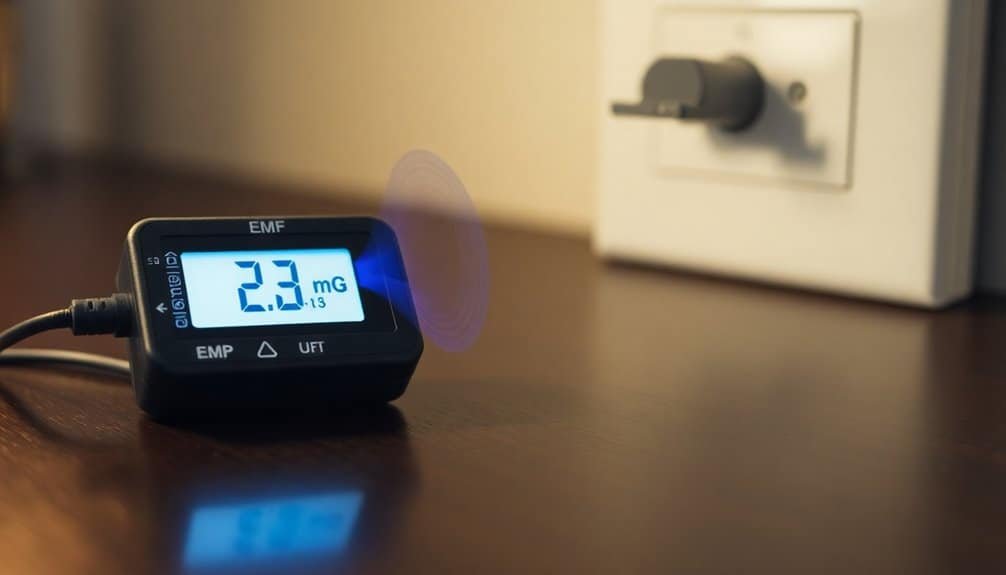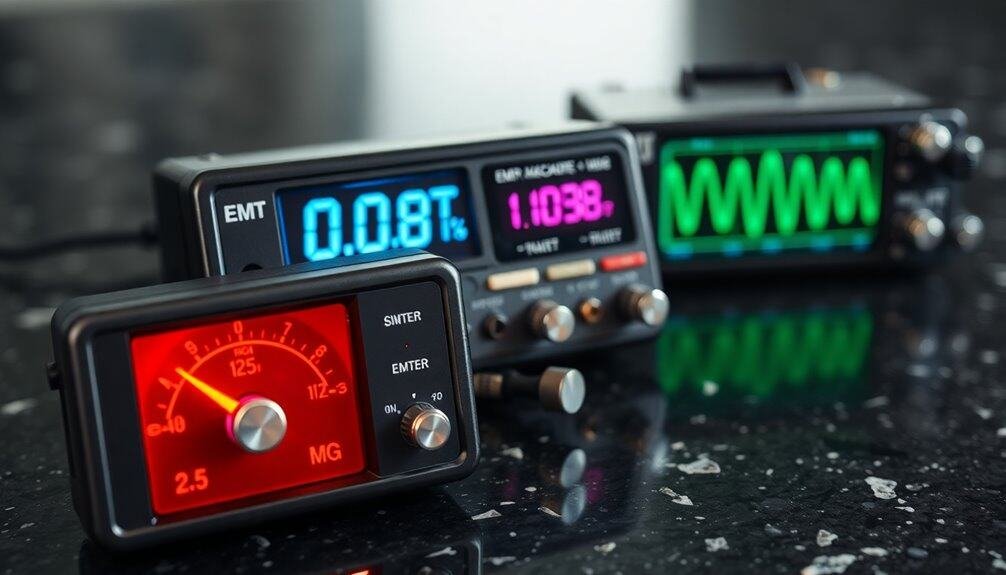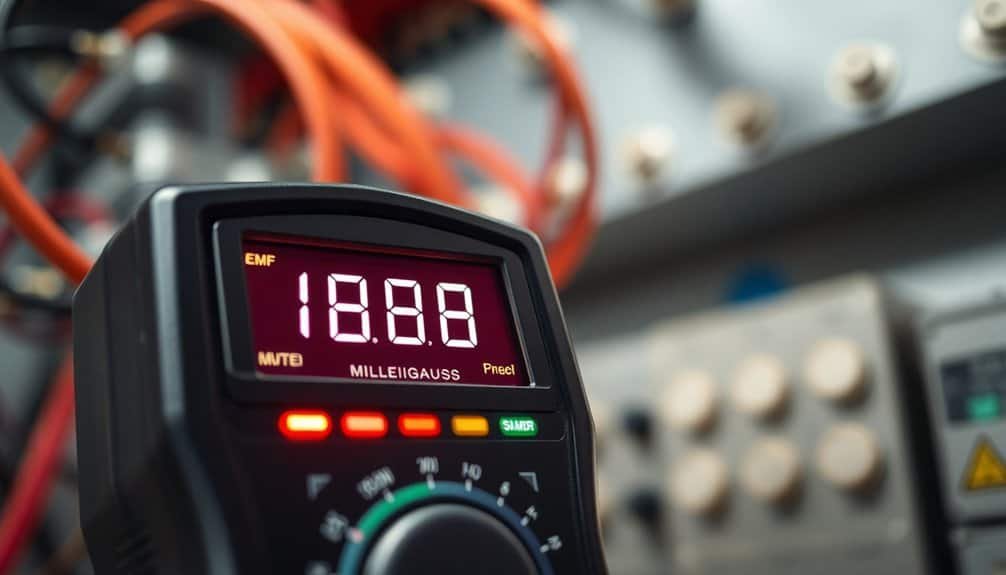Understanding EMF Meter Readings and Units
An EMF meter assesses electromagnetic fields, gauging magnetic fields in microteslas (µT) and electric fields in volts per meter (V/m), using either single-axis or tri-axis measurements. Understanding specifications such as measuring range, resolution, and accuracy is crucial.
Awareness of safety standards, established limits, and their uses is essential for interpreting EMF readings effectively. As you delve deeper, you’ll gain further insights into the implications of these measurements.
Disclaimer: As an affiliate, I may collect a share of sales from the links on this page.
What Is an EMF Meter?

An EMF meter, short for electromagnetic field meter, is a device designed to measure electromagnetic fields in various environments. It detects both static and dynamic fields from natural and man-made sources, making it essential for identifying electrical issues. In homes and workplaces, you can use it to assess potential hazards or improper wiring. EMF meters come in different types, including single and tri-axis meters, each serving a specific function. While single axis meters measure one dimension, tri-axis meters capture all three simultaneously. This capability speeds up surveys, enhancing the accuracy of environmental assessments regarding electromagnetic radiation exposure. Additionally, broadband measurements allow these meters to sense signals across a wide frequency range, further improving their utility in EMF assessments. Understanding EMF radiation helps users evaluate the safety of their environments more effectively.
Units of Measurement for EMFs
Understanding the different units of measurement for electromagnetic fields (EMFs) is essential for accurately evaluating their strength and potential impacts. Common units for magnetic fields include Tesla (T), microtesla (µT), Gauss (G), and milligauss (mG). Electric field strength is typically measured in volts per meter (V/m). Current density and magnetic field strength can also be expressed in ampere per meter (A/m). For comparative analysis, you might encounter measurements in decibels relative to a reference value. Additionally, understanding these units is crucial for applying reliable EM field strength measurements in various EMC applications.
Types of EMF Meters

When evaluating electromagnetic fields (EMFs), it’s crucial to choose the right type of EMF meter that fits your needs.
Single-axis meters measure EMF in one direction, requiring rotation to locate the strongest field.
Tri-axis meters assess all three axes at once, offering a more efficient, albeit pricier, option. These meters can provide a more comprehensive understanding of electrosmog exposure in your environment.
Gauss meters specifically target magnetic fields, while electric field meters detect electric fields from ungrounded devices, helpful for identifying wiring issues. Furthermore, EMF meters are particularly beneficial for detecting electrostatic charges on surfaces and human bodies, allowing users to assess potential health impacts related to EMFs.
Finally, RF meters focus on radiofrequency exposure from devices like Wi-Fi routers.
Choosing the appropriate meter depends on your specific application and budget.
Key Specifications to Consider
Evaluating the right EMF meter involves considering several key specifications, which can greatly impact measurement accuracy and usability.
First, check the measuring range for magnetic fields, typically between 0.01 to 99.99 µT, and electric fields, ranging from 1 to 1999 V/m.
Next, inspect the resolution, ideally 0.01 µT for precise readings.
Accuracy matters too; look for devices with ±1 V/m tolerance.
Additionally, consider the frequency response, ideally from 5 Hz to 3500 MHz.
Finally, don’t overlook battery life, with some meters lasting up to 100 hours on a 9V battery, ensuring longevity during usage. Moreover, understanding safe EMF levels is crucial for determining acceptable exposure limits while using your meter.
Reading and Interpreting EMF Results

Reading and interpreting EMF results involves understanding both the data presented by your meter and the context in which these measurements were taken.
Start by establishing baseline readings, which provide a reference to spot anomalies. Compare the type of EMF—electric or magnetic—to its distinct units, like V/m or μT.
Identify the EMF source, such as power lines, since this affects your results. Use interpretation apps to translate readings into potential health impacts.
Safety Standards and Exposure Limits
Understanding EMF readings requires awareness of established safety standards and exposure limits that govern permissible levels of electromagnetic fields.
International bodies like the IEEE and ANSI set these standards. For instance, IEEE C95.1-2019 regulates exposure from 0 Hz to 300 GHz, ensuring safety for the general public.
The FCC also adopts NCRP’s limits for RF exposure, tailored for various frequencies. OSHA enforces guidelines for ELF radiation, covering 0 to 3 kHz.
Specifically, SAR limits protect you from risks of devices near your body. Awareness of these standards is essential for evaluating your safety in environments with electromagnetic fields.
Applications of EMF Meters in Daily Life
As you navigate daily life, understanding how EMF meters can enhance your environment is crucial. These devices serve multiple practical applications, aiding in both safety and comfort.
- Measure EMF levels in various rooms, like bedrooms and kitchens.
- Identify sources of EMF, such as Wi-Fi routers and mobile phones.
- Assist in mitigating EMF exposure by optimizing device placement.
- Guarantee workplace safety by monitoring EMF levels in offices.
- Raise community awareness about EMF exposure’s potential effects.
Frequently Asked Questions
How Do I Choose the Right EMF Meter for My Needs?
To choose the right EMF meter, assess your specific needs—consider functionality, portability, and user interface. Look for reliability, research brands, and decide if you want advanced features or a basic model for your measurements.
Can EMF Readings Vary by Time of Day?
As dawn turns to dusk, daily diurnal distinctions in EMF readings occur. Midday measurements manifest higher, while nighttime numbers typically show stability. So, you’ll see shifts based on time, influenced by atmospheric activity.
What Is the Impact of Distance on EMF Readings?
Distance greatly impacts EMF readings. As you move away from the source, field strength diminishes due to the inverse-square law, making careful sensor positioning essential for accurate measurements in various environments.
How Do Weather Conditions Affect EMF Measurements?
Weather conditions are like a chameleon, constantly changing how EMF measurements appear. Rain, clouds, and temperature shifts can skew readings, transforming your data’s clarity into a murky reflection of the environment. Stay observant for accuracy!
Are There Any DIY Methods to Measure EMF?
You can measure EMF using DIY methods like building circuits with LM358 op-amps and inductors. Multimeters help with basic readings, while commercial meters offer thorough evaluations. Experimenting with these tools enhances your understanding of EMF levels.
Conclusion
Understanding EMF meter readings allows you to make informed environmental decisions. Just as a lighthouse guides ships, EMF meters help identify electromagnetic fields, ensuring a safer space. As technology advances, staying aware of EMF exposure is crucial for maintaining health and well-being.






